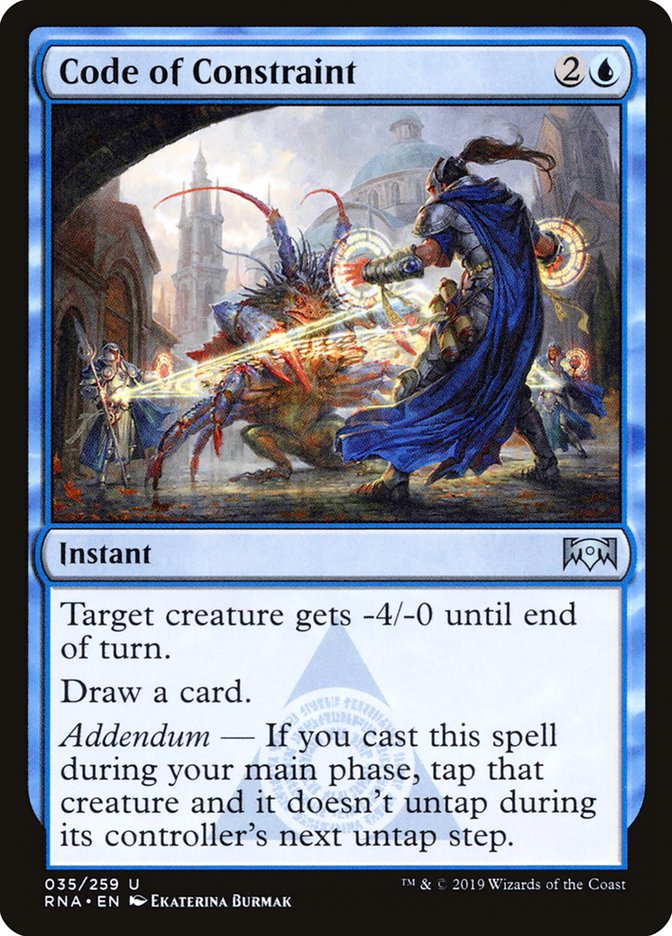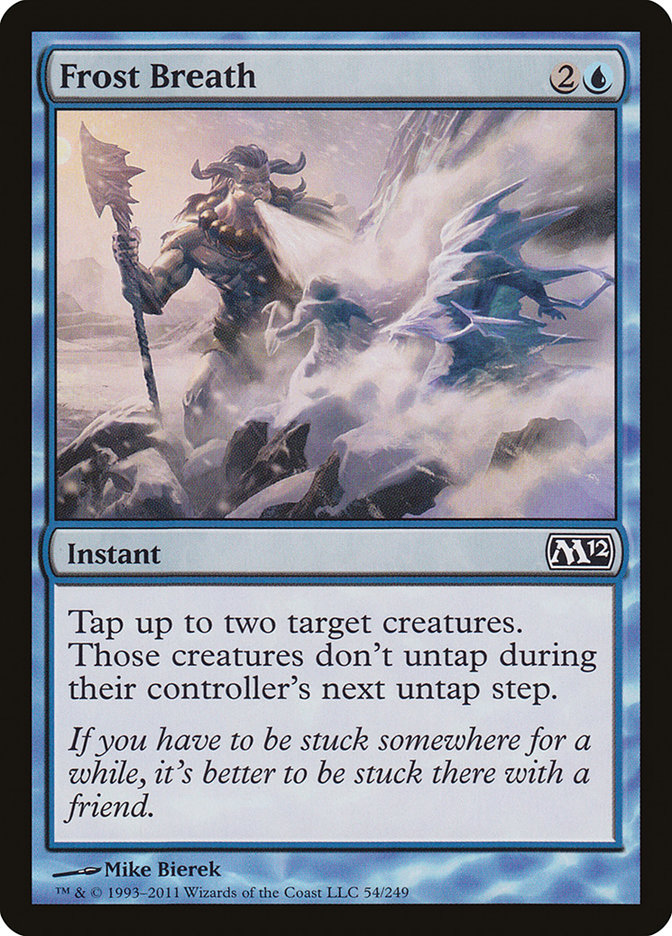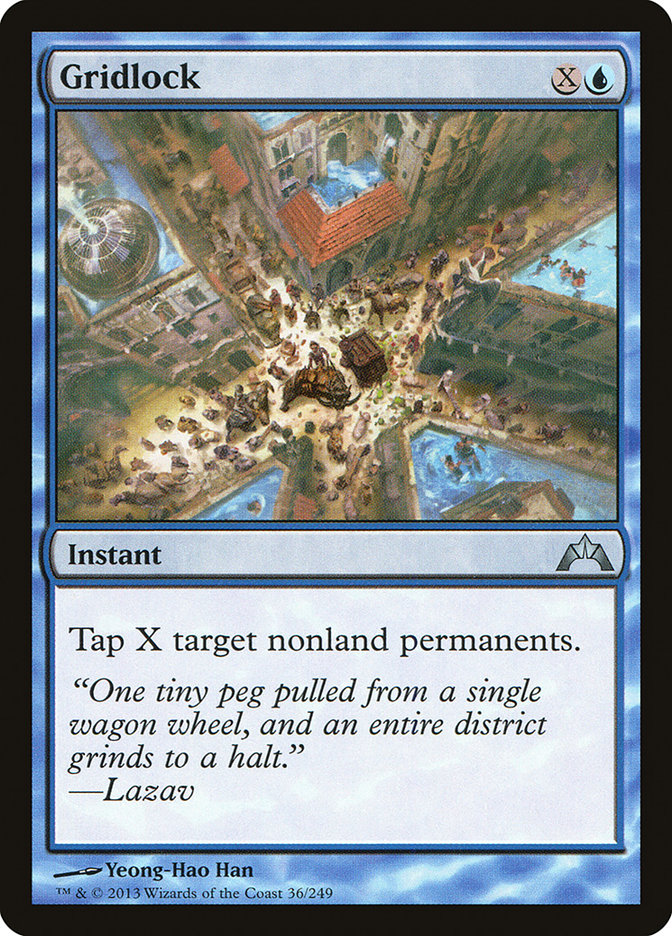Code of Constraint MTG Card
| Card sets | Released in 2 setsSee all |
| Mana cost | |
| Converted mana cost | 3 |
| Rarity | Uncommon |
| Type | Instant |
| Abilities | Addendum |
Text of card
Target creature gets -4/-0 until end of turn. Draw a card. Addendum — If you cast this spell during your main phase, tap that creature and it doesn't untap during its controller's next untap step.
Cards like Code of Constraint
Code of Constraint stands out in the realm of control spells in MTG. It finds its parallels in cards like Frost Breath, which can immobilize multiple creatures, preventing them from untapping during the next untap step. However, Code of Constraint’s versatility comes forward with the additional upside of card draw if cast during your main phase. Unlike Frost Breath, which is purely reactive, Code of Constraint can also proactively contribute to your hand while hampering an opponent’s board.
Another card that echoes the essence of Code of Constraint is Gridlock. While Gridlock allows you to tap down multiple nonland permanents, it lacks the card draw benefit that makes Code of Constraint a compelling choice for decks looking to maintain card advantage. Additionally, Code of Constraint interacts with the Addendum mechanic, offering a built-in incentive for strategic timing that Gridlock does not provide.
Understandably, when exploring options for control and card advantage, Code of Constraint offers a blend that might appeal to players who value flexibility in their control spells, making it a noteworthy inclusion in MTG strategies focused on tempo and resourcefulness.
Card Pros
Card Advantage: Code of Constraint is adept at adding to your hand while simultaneously hindering your opponent. When played, the card not only taps a target creature, which can impede incoming attacks or key blockers but it also has the coveted Addendum ability. If cast during your main phase, you draw a card, thus increasing your resources and maintaining pressure on the board.
Resource Acceleration: While not directly providing mana acceleration like some other spells, Code of Constraint can be a pivotal play that slows down your opponent’s board development. By tapping down potential threats or would-be blockers, you gain the indirect benefit of being able to commit more to the board yourself, essentially accelerating your game plan versus theirs.
Instant Speed: The instant speed nature of Code of Constraint serves dual purposes in a match. It enables you to react with precision to your opponent’s plays during their turn, potentially disrupting their strategies at a critical moment. Coupled with the Addendum benefit, it encourages strategic planning, allowing you to choose whether to use it as a quick disruption tool or to wait for the optimum moment for maximum card advantage.
Card Cons
Discard Requirement: The Code of Constraint MTG card demands that a player discards a card in order to activate its full potential. This can be a double-edged sword, particularly if your hand is already depleted, rendering the cost sometimes too steep in situations where card advantage is crucial.
Specific Mana Cost: Featuring both blue and white mana in its casting cost, Code of Constraint can often be restrictive. It’s not just any mana that will suffice, which means this card is primarily viable in Azorius decks or others that can reliably produce both types of mana.
Comparatively High Mana Cost: With a casting cost that sits higher on the curve, it’s possible to argue that Code of Constraint may not be the most mana-efficient choice for control tools. In a game where tempo and resource management are key, players might find other lower-cost cards to be more versatile or to have a quicker impact on the game state.
Reasons to Include Code of Constraint in Your Collection
Versatility: Code of Constraint offers strategic options across several blue-based decks due to its ability to hinder opponents by tapping their creatures and potentially drawing a card. This makes it useful for tempo plays and maintaining board control.
Combo Potential: In decks that revolve around casting multiple spells in a single turn or focus on instant-speed interactions, Code of Constraint can be a key piece, especially since it can be cast during an opponent’s turn, aligning perfectly with reactive game plans.
Meta-Relevance: Given its disruptive ability, Code of Constraint proves its worth in metas dominated by aggressive creature-centric decks. Slowing down your opponent’s momentum while refilling your hand can be crucial for staying ahead in the game.
How to Beat Code of Constraint
Overcoming Code of Constraint requires strategic play and a carefully curated deck. In the context of Magic: The Gathering, it is comparable to cards like Unsubstantiate or Disperse, which can help players to temporarily deal with threats by returning them to their owner’s hand. Nonetheless, Code of Constraint has the additional advantage of drawing a card, along with its Addendum ability, which taps the target creature if cast during your main phase. To counteract this, consider utilizing instant speed spells that can be played in response to Code of Constraint. Cards that give your creatures hexproof, like Blossoming Defense, can effectively nullify its effects, ensuring your creatures remain a threat on the board.
Furthermore, a deck with a robust counterspell strategy can help as well. By keeping mana open, you can thwart your opponent’s attempt to cast Code of Constraint, maintaining board advantage. Cards such as Negate or Dovin’s Veto are particularly effective, as they’re designed to specifically counter noncreature spells. Remember, being proactive and predictive of your opponent’s moves grants you the upper hand and positions you to successfully beat the handcuff effects of Code of Constraint.
Where to buy
If you're looking to purchase Code of Constraint MTG card by a specific set like Ravnica Allegiance and Ravnica: Clue Edition, there are several reliable options to consider. One of the primary sources is your local game store, where you can often find booster packs, individual cards, and preconstructed decks from current and some past sets. They often offer the added benefit of a community where you can trade with other players.
For a broader inventory, particularly of older sets, online marketplaces like TCGPlayer, Card Kingdom and Card Market offer extensive selections and allow you to search for cards from specific sets. Larger e-commerce platforms like eBay and Amazon also have listings from various sellers, which can be a good place to look for sealed product and rare finds.
Additionally, Magic’s official site often has a store locator and retailer lists for finding Wizards of the Coast licensed products. Remember to check for authenticity and the condition of the cards when purchasing, especially from individual sellers on larger marketplaces.
Below is a list of some store websites where you can buy the Code of Constraint and other MTG cards:
 BUY NOW
BUY NOW BurnMana is an official partner of TCGPlayer
- eBay
- Card Kingdom
- Card Market
- Star City Games
- CoolStuffInc
- MTG Mint Card
- Hareruya
- Troll and Toad
- ABU Games
- Card Hoarder Magic Online
- MTGO Traders Magic Online
See MTG Products
Printings
The Code of Constraint Magic the Gathering card was released in 2 different sets between 2019-01-25 and 2024-02-23. Illustrated by Ekaterina Burmak.
| # | Released | Name | Code | Symbol | Number | Frame | Layout | Border | Artist |
|---|---|---|---|---|---|---|---|---|---|
| 1 | 2019-01-25 | Ravnica Allegiance | RNA | 35 | 2015 | Normal | Black | Ekaterina Burmak | |
| 2 | 2024-02-23 | Ravnica: Clue Edition | CLU | 83 | 2015 | Normal | Black | Ekaterina Burmak |
Legalities
Magic the Gathering formats where Code of Constraint has restrictions
| Format | Legality |
|---|---|
| Historicbrawl | Legal |
| Commander | Legal |
| Historic | Legal |
| Legacy | Legal |
| Modern | Legal |
| Oathbreaker | Legal |
| Vintage | Legal |
| Duel | Legal |
| Explorer | Legal |
| Gladiator | Legal |
| Pioneer | Legal |
| Timeless | Legal |
Rules and information
The reference guide for Magic: The Gathering Code of Constraint card rulings provides official rulings, any errata issued, as well as a record of all the functional modifications that have occurred.
| Date | Text |
|---|---|
| 2019-01-25 | Addendum abilities of instant spells apply while the spell is resolving, not immediately after casting it. If the spell is countered, you don’t get the addendum bonus. For example, if you cast Sphinx’s Insight during your main phase, you gain 2 life during its resolution, after you draw two cards. |
| 2019-01-25 | Code of Constraint can target a creature that’s already tapped. If you cast it during your main phase, that creature won’t untap during its controller’s next untap step. |
| 2019-01-25 | If a spell with an addendum ability is copied, the copy won’t give you the addendum bonus. This is because the copy wasn’t cast at all. |
| 2019-01-25 | If the target creature is an illegal target by the time Code of Constraint tries to resolve, the spell doesn’t resolve. You don’t draw a card. |



